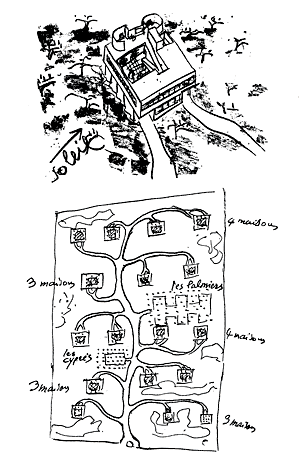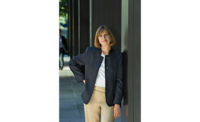Once upon a time, Le Corbusier sat in his single-room office alone, pencil in hand, solemnly pondering an architectural problem, “face to face with himself, the wrestling of Jacob and the Angel within the human soul,” as he explained in volume eight of Oeuvres Complètes. About one project he wrote, “This took a long time to develop, the design worked upon and caressed in days of perfect calm.” His famous dictum was “creation is a patient search.” Each new edition of the Oeuvres Complètes was eagerly anticipated, and although it would come out only every few years with a limited number of projects, every one was marked by an extraordinary level of originality and power: the Villa Savoie, La Tourette, Ronchamp, Maisons Jaoul, the High Court and Assembly at Chandigarh, the Carpenter Center.

Never did more than 15 people work at his office at 35 rue de Sevres, in Paris. Similarly, Louis Kahn never had more than 20 architects at his office in Philadelphia. Of the 40 desks at each of Frank Lloyd Wright’s Taliesin studios (East and West), only 20 were ever occupied. At the most, James Stirling’s staff was around 25. And, of course, Carlo Scarpa worked with maybe 6 people in his own home office in Vicenza, Italy.
But that was then, and this is now, a time when the world is awash with money, new clients are everywhere, and architects are called upon to build in every corner of the globe as fast as possible, today if not yesterday. With Blackberries, cell phones, wireless computers, and faxes, one is expected to create and produce buildings at an unprecedented scale and rate. And this at a time, at least in the media, when architecture’s stock has risen to historic highs. Back when Le Corbusier was working in India and Louis Kahn in Bangladesh (then Pakistan), these locales were considered remote and exotically quaint. Today, construction has exploded in China, Singapore, the Philippines, Thailand, and Dubai.
So what is wrong with this picture? In the 1970s and early ’80s, when there was little work, every Michael Graves yellow trace sketch was the talk of the town. Now there is not only a cornucopia of projects, but a lot of architects’ wildest fantasies are actually being built in places like Shanghai and Dubai.
Isn’t this what every architect wants—larger projects, bigger offices, and fatter budgets? Yes, but … A large office is not only a blessing, but also a curse. There is the inevitable loss of control—“many a slip betwixt cup and lip”—as directions from the design partner to subordinates, and then through construction drawings to the contractor, are lost or mistranslated. And, as we know, it is almost impossible to construct even the simplest things correctly. In an office, everyone has a personality, attitude, and ego, especially in a field rife with prima donnas. You must be really “hot” to get a job at Zaha’s! Architecture often winds up being more about managing people than design. As Bill Pedersen of Kohn Pedersen Fox told me after I proudly informed him I had hired my first employee, “Now the trouble begins.”
So how is it possible for architects who have arrived at the pinnacle of their profession and are known for the intensity of their design and their obsession to detail to expand successfully to a size that rivals the large corporate firms? Can one have an atelier of 200 people working at the same level of originality and care as one of 20? There is a clear and present danger that too much work will dilute the production of even the best firms. History is strewn with the wreckage of bloated offices’ late work, such as any of Ed Barnes’s or Ulrich Franzen’s faceless towers. And can anyone forgive Walter Gropius his horrendous Pan Am Building?
Both Frank Gehry and Zaha Hadid now have offices with more than 200 people. Not only do they have numerous projects of gigantic scale, but the distance between projects requires the architects to spend a great deal of time on planes. Is it possible to maintain the quality of design at this size and with projects flung across the world? Is there a danger of repeating oneself when clients demand a “Gehry” or “Zaha” for their city or museum? Does it matter?
On the opposite end of the spectrum is Glenn Murcutt, who works alone and refuses to take projects outside of Australia, as he believes one can only build where one completely understands the site. This extreme position—the architect as a kind of local tribal shaman—does not make enormous sense with the realities of global communications (actually since the invention of the telephone), but it does raise the issue of how to build appropriately in different locations, climates, and cultures. This has been a problem of Modernism since Philip Johnson and Henry-Russell Hitchcock’s 1932 MoMA exhibition declared there was one International Style suitable for all locations. This long-discredited notion, oddly enough, is being raised again through the multiple commissions of boutique architects asked to repeat their “signature” projects regardless of the site. Do Richard Meier’s glass towers on the Hudson in New York make sense near Miami in even more Minimal garb?
Both Le Corbusier and Mies van der Rohe walked the fine line between innovation and repetition, but did so within the context of solving a problem in an architectural typology. One of the answers to housing for Le Corbusier was the slab of the Marseilles block, where duplex apartments were stacked within a structural frame, the whole building was raised off the ground on pilotis, and a terrace occupied the roof. He repeated versions of this scheme in Berlin and Briey-le-Forêt, and proposed them in all of his urban plans. Were they all as well done as Marseilles? Perhaps not, but they were to be seen together as a laboratory of investigation, refining an answer to a clearly stated problem. The same goes for Mies, in his series of corporate office buildings: Seagram in New York City, IBM and the Federal Center in Chicago, and Westmount Square in Montreal. Mies developed a language that for him was an expression of the “zeitgeist,” the spirit of the age, and therefore needed no excuse for “originality.” Refinement was the goal; each was as subtly different as one Greek temple was from another. For myself, Seagram trumps them all, but that was not the point.





Post a comment to this article
Report Abusive Comment